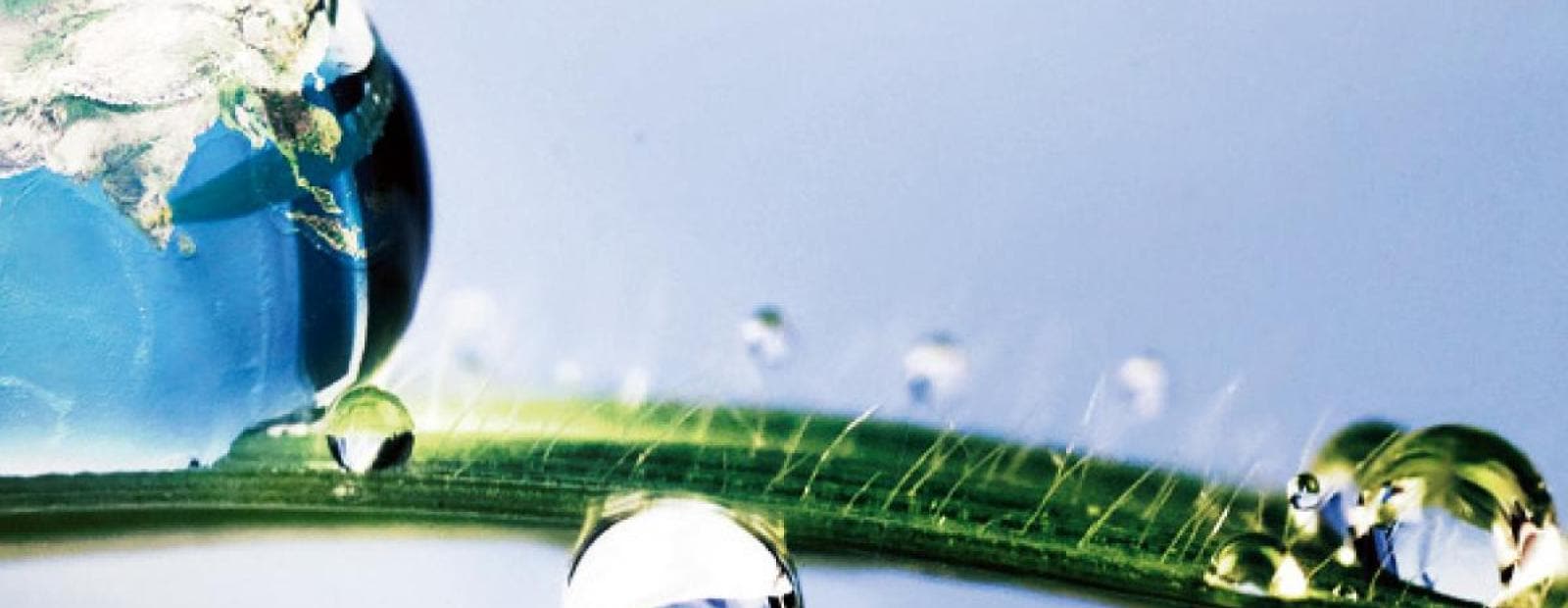Making Every Drop Count
Water is one of the world’s most valuable resources, but it is becoming increasingly scarce. Farmers and scientists are counteracting this issue by applying methods to use water more efficiently in agriculture.
Global water resources are under a variety of serious threats: In one part of the world, Mexico may struggle with extreme drought, but flooding may haunt Australia at the same time. “Unequal water resources and water scarcity are the most tangible dimensions and consequences of climate change, in terms of changing precipitation patterns, and generally more variability and uncertainty,” says Jan Lundqvist, Senior Scientific Advisor at Sweden’s Stockholm International Water Institute (SIWI).
Today, severe water shortages are occurring in many regions of the world. Overall, around 1.2 billion people, or almost one-fifth of the world's population, already live in areas of physical scarcity—and this trend is increasing. According to the United Nations, by 2025 there will be 1.8 billion people living in regions with absolute water scarcity, and two-thirds of the world's population could be living under water-stressed conditions caused by climate change.
For farmers, this increasing water scarcity is threatening since their work depends directly on this precious resource. “Water is often relatively more limited than land, and it is uncertain. In principle, although not in practice, food can be grown without land, but not without water,” states Lundqvist. In fact, 70 percent of the global freshwater supply is used to support agricultural production.
Today’s agriculture uses about 70 percent of the world’s freshwater supply.
These urgent conditions mean an emphasis on efficiency: Growers have to use fresh approaches to derive a bigger harvest from the same plots while reducing their overall water use. Ed Fagan, a vegetable farmer from Cowra, a town in New South Wales, Australia, is already practicing a fresh growing strategy that uses water as efficiently as possible: “Since we don’t get a lot of rainfall, water is a critical part of agriculture in Australia. That’s why, on our farm, we aim to grow as much as we can in the temperate and cool period of the year to use less water.”
Maximizing the crop per drop
Farmers are also increasing the efficiency of water usage by making use of drip irrigation. With this method, tube hoses distribute water throughout the fields, allowing water to slowly drip directly to the roots of the crops. As opposed to conventional aerial irrigation, this method enables farmers to apply water precisely for direct intake by the plant without waste due to excessive evaporation or imprecise coverage.
But drip irrigation is more than a close-up watering approach. It also uses soil humidity sensors that provide exact information about how much water is needed at a specific point in a plant’s life cycle, automating the water application process. This way, drip irrigation delivers water at the precise moment when it is needed.
This more efficient use of water translates into enormous economic savings for farmers. “In fact, drip irrigation provides water-use efficiency of more than 95 percent. That translates to a water-use reduction of more than 40 percent over traditional flooding methods. It’s more efficient, can be automated and is less labor-intensive,” says Holger Weckwert, Global Segment Manager Fruits & Vegetables and Insecticides at Bayer.
Mexican farmer Daniel Cevallos stopped using his traditional water approach, using channels between his fields, in favor of a drip irrigation system. He doesn’t regret this decision. “Drip irrigation allows me to irrigate my crops precisely—as much water as necessary, as little water as possible. This way, I don’t waste a drop. This system has already benefitted me tremendously because it has protected me against high losses during a severe drought.”
Bayer and its partner Netafim are tackling the water scarcity issue head-on with the DripByDrip irrigation solution. In this new approach, both water and crop protection are distributed throughout the fields via the drip irrigation system and then delivered directly to the roots of the crops. Currently, the system focuses on fruit and vegetable production in all arid and semi-arid regions of the world, and it will next support crops like cotton, sugarcane, and rice.
And another way for farmers to use water with precision is through digital farming: Based on data gathered by drones, satellites, and sensors, farmers receive field recommendations. Using digital technologies, farmers can time their irrigation systems much better to save water, receive planting date recommendations and re-planting advice, and assess their soil’s water storage capacity.
Protecting water with Phytobac
Farmers can also apply measures to protect water from being wasted due to contamination with crop protection residues. A system called Phytobac allows farmers to direct their wash water into special tanks with microbes that instinctively degrade any crop protection residuals. This system not only saves water, but it also prevents product residues from getting into sewage systems or nearby bodies of water. Dutch farmer Jasper Roubos is one of more than 4,000 farmers in Europe using Phytobac so far. “Whenever I clean my crop protection spraying equipment, I know with Phytobac that I’m contributing water preservation,” he explains.

The wash water is distributed over a substrate of soil and straw in a waterproof container 1. Potential product residues are degraded biologically 2. and the clean water evaporates 3. The straw in the Phytobac 4. serves to feed the microorganisms and is stocked up once a year. Once set up, a substrate can be used over many years.
Drought-tolerant plant varieties
In addition to farmers, researchers worldwide are also taking action to alleviate the increasing danger of water scarcity for agriculture. For example, they are developing new plant varieties that better adapt to regional climate conditions and save water resources. This breeding approach is urgently needed: An average temperature increase of just one degree equates to wheat harvest losses of some ten percent in developing countries.
In laboratories of Bayer, scientists develop effective breeding methods for wheat. To achieve this, they perform extremely precise work: For example, the breeders use sterile tweezers to remove stamens from wheat ears. This process ensures that the plants cannot self-pollinate and that they can, therefore, be selectively crossbred.
To counteract this circumstance, biotechnologists at the Wheat Breeding Centers from Bayer around the globe have been developing new drought and stress-tolerant wheat varieties. In their laboratories, the researchers can adjust the climate conditions to simulate a hot summer, a chilly and damp spring or a season of extreme drought. The goal is to breed plants that provide higher yields under the local climate and soil conditions and are better able to withstand pests and diseases, but also extreme weather. This way, farmers are able to grow robust wheat plants that use less water.
A similar approach is followed by a partnership between Bayer and CSIRO, Australia’s federal government agency for scientific research, based in Canberra. “Down under, we farm on the driest continent on earth. Due to water constraints, we aim to breed high yielding wheat varieties that can withstand these dry conditions. This way farmers can save more water,” says CSIRO director John Manners.
Scientists have estimated that by 2030 the gap between expected water withdrawal and existing supply has the potential to reach as high as 40 percent. So regardless of which water-saving strategies are used in agriculture, they all aim for the same result: fostering better water management in agriculture to maximize the “crop per drop,” while saving water, and preserving the environment.

"Water is on top of the global risks"
Jan Lundqvist, Senior Scientific Advisor at Sweden’s Stockholm International Water Institute (SIWI), outlines developments and factors in the field of water usage and efficiency.
What significance does water have for agriculture and for the world in general?
Water continues to be crucial in agriculture and, of course, in other sectors and for the environment as well. Water is even so important that it’s addressed in one of the Sustainable Development Goals (SDGs) created by the United Nations to ensure availability and sustainable management of water and sanitation for all.
Unequal water resources and water scarcity are the most tangible dimension and consequence of climate change, in terms of changing precipitation patterns and generally more variability and uncertainty. It’s not just farmers who recognize this challenge. For a number of years the Global Risks Report from the World Economic Forum has illustrated that water is on top of the global risks as perceived by major decision makers, both in terms of likelihood and impact.
What are the challenges we face in achieving a higher standard of efficiency in water usage?
Generally, high efficiency hinges on sociopolitical and technical issues. In irrigated systems, it is crucial to have a good relationship and mutual trust between farmers and people who control water provisions. Technical systems, such as gates and various details of the conveyance structure, are important to physically control water and reduce seepage.
In rain-fed systems, the challenges are different. In this case, it is more of a combined soil, landscape and water management task because land management is also rainwater management. Farmers in many countries have developed various types of rainwater harvesting methods, such as using small ponds and tanks to collect water, creating barriers to reduce surface runoff, mulching for enhanced water retention capacity and practicing low or no-till agriculture. So growing the ‘right’ crops is essential.





















